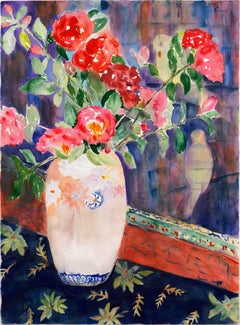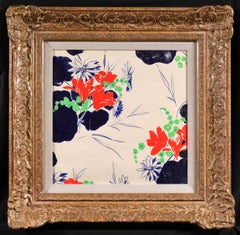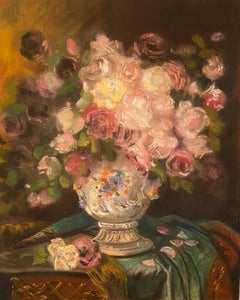Thomas Haight Art
to
1
Overall Width
to
Overall Height
to
1
1
1
1
1
1
1
1
1
10,138
2,779
1,375
1,369
1
Artist: Thomas Haight
'Dog Roses in a Satsuma Vase', Japanese Decorative Arts, Lacquer Mirror
By Thomas Haight
Located in Santa Cruz, CA
A substantial and vibrant watercolor still-life showing a loose group of pink and red dog-roses informally arranged in an ivory-field, satsuma vase, set on a floral-pattern tableclot...
Category
1980s Post-Impressionist Thomas Haight Art
Materials
Paper, Watercolor, Board
Related Items
Projet de Tissus - Fauvist Flowers Watercolor & Gouache by Raoul Dufy
By Raoul Dufy
Located in Marlow, Buckinghamshire
Botanical watercolour and gouache on paper circa 1920 by French fauvist painter Raoul Dufy. The work depicts flowers in red, blue and green. This work was executed by Dufy as a fabric design.
Dimensions:
Framed: 19.5"x19.5"
Unframed: 12"x12"
Provenance:
Private collection of works by Raoul Dufy for Bianchini Ferier
Bianchini Ferrier Collection - Christie's London - July 2001
SF Fall Show
Raoul Dufy was one of a family of nine children, including five sisters and a younger brother, Jean Dufy, also destined to become a painter. Their father was an accountant in the employ of a major company in Le Havre. The Dufy family was musically gifted: his father was an organist, as was his brother Léon, and his youngest brother Gaston was an accomplished flautist who later worked as a music critic in Paris. Raoul Dufy's studies were interrupted at the age of 14, when he had to contribute to the family income. He took a job with an importer of Brazilian coffee, but still found time from 1892 to attend evening courses in drawing and composition at the local college of fine arts under Charles Marie Lhullier, former teacher of Othon Friesz and Georges Braque. He spent his free time in museums, admiring the paintings of Eugène Boudin in Le Havre and The Justice of Trajan in Rouen. A municipal scholarship enabled him to leave for Paris in 1900, where he lodged initially with Othon Friesz. He was accepted by the École des Beaux-Arts, where he studied under Léon Bonnat, whose innate conservatism prompted Dufy to remark later that it was 'good to be at the Beaux-Arts providing one knew one could leave'.
And leave he did, four years later, embarking with friends and fellow students on the rounds of the major Paris galleries - Ambroise Vollard, Durand-Ruel, Eugène Blot and Berheim-Jeune. For Dufy and his contemporaries, Impressionism represented a rejection of sterile academism in favour of the open-air canvases of Manet, the light and bright colours of the Impressionists, and, beyond them, the daringly innovative work of Gauguin and Van Gogh, Seurat, Cézanne, Toulouse-Lautrec and others. Dufy was an out-and-out individualist, however, and was not tempted to imitate any of these artists. He produced, between 1935 and 1937, Fée Electricité (Spirit of Electricity), the emblem for the French utilities company Electricité de France (EDF).
Dufy visited the USA for the first time in 1937, as a member of the Carnegie Prize jury. In 1940, the outbreak of war (and his increasingly rheumatic condition) persuaded him to settle in Nice. When he eventually returned to Paris 10 years later, his rheumatism had become so debilitating that he immediately left for Boston to follow a course of pioneering anti-cortisone treatment. He continued working, however, spending time first in Harvard and then in New York City before moving to the drier climate of Tucson, Arizona. The cortisone treatment was by and large unsuccessful, although he did recover the use of his fingers. He returned to Paris in 1951 and decided to settle in Forcalquier, where the climate was more clement. Within a short time, however, he was wheelchair-bound. He died in Forcalquier in March 1953 and was buried in Cimiez.
Between 1895 and 1898, Raoul Dufy painted watercolours of landscapes near his native Le Havre and around Honfleur and Falaise. By the turn of the century, however, he was already painting certain subjects that were to become hallmarks of his work - flag-decked Parisian cityscapes, Normandy beaches teeming with visitors, regattas and the like, including one of his better-known early works, Landing Stage at Ste-Adresse. By 1905-1906 Friesz, Braque, Matisse, Derain, Vlaminck, Van Dongen and Rouault were described collectively as Fauves (the wild beasts). What they had in common was a desire to innovate, but they felt constrained nonetheless to meet formally to set out the guiding principles of what promised to be a new 'movement'. Dufy quickly established that those principles were acceptable; moreover, he was most impressed by one particular painting by Henri Matisse ( Luxury, Calm and Voluptuousness) which, to Dufy, embodied both novelty and a sense of artistic freedom. Dufy promptly aligned himself with the Fauves. Together with Albert Marquet in particular, he spent his time travelling the Normandy coast and painting views similar...
Category
1920s Fauvist Thomas Haight Art
Materials
Paper, Watercolor, Gouache
$12,771
H 19.5 in W 19.5 in
“Roses in a Porcelain Vase”
By Marcel Vertès
Located in Southampton, NY
Here for your consideration is a very well executed oil pastel on archival paper by the well known French artist, Marcel Vertes. Signed lower right. Condition is excellent. Circa 1...
Category
1930s Post-Impressionist Thomas Haight Art
Materials
Oil Pastel, Archival Paper
Tulips , White
Located in Zofingen, AG
In this piece, I poured vibrant emotions through acrylic, oil pastel, and colored pencil, blending expressionism, impressionism, and pop art to capture the delicate yet bold spirit o...
Category
2010s Pointillist Thomas Haight Art
Materials
Oil Pastel, Acrylic, Archival Paper
1945 Wartime Still Life Watercolor English Coveted Ceramic Artist And Teacher
By James Tower
Located in Sutton Poyntz, Dorset
James Tower.
English ( b.1919 - d.1988 ).
Still Life Of Cut Flowers In A Pottery Jug, 1945.
Watercolor & Ink.
Signed & Dated Lower Right.
Image size 13.2 inches x 10 inches ( 33.5c...
Category
Mid-20th Century Post-Impressionist Thomas Haight Art
Materials
Paper, Ink, Watercolor
$3,435
H 19.89 in W 16.54 in D 0.48 in
1940s Wartime Still Life Watercolor Painting By A Famous Ceramic Potter Sculptor
By James Tower
Located in Sutton Poyntz, Dorset
James Tower.
English ( b.1919 - d.1988 ).
Still Life Of Flowers In A Jug And A Plate Of Fruit.
Watercolor & Ink.
Image size 15.4 inches x 13 inches ( 39cm x 33cm ).
Frame size 22.2 ...
Category
Mid-20th Century Post-Impressionist Thomas Haight Art
Materials
Paper, Ink, Watercolor
$3,435
H 22.25 in W 19.3 in D 0.48 in
Projet de Tissus - Fauvist Still Life Study Gouache by Raoul Dufy
By Raoul Dufy
Located in Marlow, Buckinghamshire
Botanical gouache on paper circa 1920 by French fauvist painter Raoul Dufy. The work depicts a study of apples and pears. This work was executed by Dufy as a fabric design.
Dimensio...
Category
1920s Fauvist Thomas Haight Art
Materials
Paper, Gouache
$19,126
H 27 in W 26.75 in
“Roses and Pansies”
Located in Southampton, NY
Very well executed watercolor and gouache on heavy card stock of a spring bouquet composed of mainly roses and pansies. Unsigned. Circa 1915. Original gold painted wood frame. Under...
Category
1910s Post-Impressionist Thomas Haight Art
Materials
Watercolor, Gouache, Cardboard
French Neo-Impressionist Still Life Pointillist Mid 20th Century Painting
By Louis Bellon
Located in Cirencester, Gloucestershire
Neo Impressionist Still Life
by Louis Bellon (French 1908-1998)
signed lower right
gouache painting on paper, unframed
measurements: 10 x 12.75 inche...
Category
Mid-20th Century Pointillist Thomas Haight Art
Materials
Gouache
$1,211 Sale Price
20% Off
H 10 in W 12.75 in
Flower Pot, Impressionist Gouache Painting by Eugene Baboulene
By Eugene Baboulene
Located in Long Island City, NY
Artist: Eugene Baboulene, French (1905 - 1994)
Title: Flower Pot
Year: circa 1960
Medium: Gouache on Paper, signed and dedicated l.r.
Size: 20 in. x 13 in. ...
Category
1960s Post-Impressionist Thomas Haight Art
Materials
Gouache
"Yellow Daises" - Watercolor on Illustration Board
Located in Soquel, CA
Vibrant, saturated watercolor of yellow daises and other flowers by Walnut Creek, California artist Olga Degles (French/American, 1911-1999). Several dais...
Category
Mid-20th Century Impressionist Thomas Haight Art
Materials
Watercolor, Illustration Board
$520 Sale Price
20% Off
H 21 in W 17.25 in D 1.5 in
Tribute to Photography - Original watercolor
By Gaston Coppens
Located in Paris, IDF
Gaston COPPENS (1909 - 2002)
Tribute to Photography
Original watercolor and tempera
Bearing the artist stamp on the back
On vellum (oval cut) 45 x 62 cm (c. 18 x 25 inch)
Excellent...
Category
Mid-20th Century Post-Impressionist Thomas Haight Art
Materials
Tempera, Watercolor
Fleurs et Papillons - Fauvist Flowers Watercolor & Gouache by Raoul Dufy
By Raoul Dufy
Located in Marlow, Buckinghamshire
Botanical watercolour and gouache on paper circa 1920 by French fauvist painter Raoul Dufy. The work depicts flowers in red and butterflies in blues, yellows, black and white. This work was executed by Dufy as a fabric design.
Dimensions:
Framed: 17"x27"
Unframed: 10"x20"
Provenance:
Private collection of works by Raoul Dufy for Bianchini Ferier
Bianchini Ferrier Collection - Christie's London - July 2001
SF Fall Show
Raoul Dufy was one of a family of nine children, including five sisters and a younger brother, Jean Dufy, also destined to become a painter. Their father was an accountant in the employ of a major company in Le Havre. The Dufy family was musically gifted: his father was an organist, as was his brother Léon, and his youngest brother Gaston was an accomplished flautist who later worked as a music critic in Paris. Raoul Dufy's studies were interrupted at the age of 14, when he had to contribute to the family income. He took a job with an importer of Brazilian coffee, but still found time from 1892 to attend evening courses in drawing and composition at the local college of fine arts under Charles Marie Lhullier, former teacher of Othon Friesz and Georges Braque. He spent his free time in museums, admiring the paintings of Eugène Boudin in Le Havre and The Justice of Trajan in Rouen. A municipal scholarship enabled him to leave for Paris in 1900, where he lodged initially with Othon Friesz. He was accepted by the École des Beaux-Arts, where he studied under Léon Bonnat, whose innate conservatism prompted Dufy to remark later that it was 'good to be at the Beaux-Arts providing one knew one could leave'.
And leave he did, four years later, embarking with friends and fellow students on the rounds of the major Paris galleries - Ambroise Vollard, Durand-Ruel, Eugène Blot and Berheim-Jeune. For Dufy and his contemporaries, Impressionism represented a rejection of sterile academism in favour of the open-air canvases of Manet, the light and bright colours of the Impressionists, and, beyond them, the daringly innovative work of Gauguin and Van Gogh, Seurat, Cézanne, Toulouse-Lautrec and others. Dufy was an out-and-out individualist, however, and was not tempted to imitate any of these artists. He produced, between 1935 and 1937, Fée Electricité (Spirit of Electricity), the emblem for the French utilities company Electricité de France (EDF).
Dufy visited the USA for the first time in 1937, as a member of the Carnegie Prize jury. In 1940, the outbreak of war (and his increasingly rheumatic condition) persuaded him to settle in Nice. When he eventually returned to Paris 10 years later, his rheumatism had become so debilitating that he immediately left for Boston to follow a course of pioneering anti-cortisone treatment. He continued working, however, spending time first in Harvard and then in New York City before moving to the drier climate of Tucson, Arizona. The cortisone treatment was by and large unsuccessful, although he did recover the use of his fingers. He returned to Paris in 1951 and decided to settle in Forcalquier, where the climate was more clement. Within a short time, however, he was wheelchair-bound. He died in Forcalquier in March 1953 and was buried in Cimiez.
Between 1895 and 1898, Raoul Dufy painted watercolours of landscapes near his native Le Havre and around Honfleur and Falaise. By the turn of the century, however, he was already painting certain subjects that were to become hallmarks of his work - flag-decked Parisian cityscapes, Normandy beaches teeming with visitors, regattas and the like, including one of his better-known early works, Landing Stage at Ste-Adresse. By 1905-1906 Friesz, Braque, Matisse, Derain, Vlaminck, Van Dongen and Rouault were described collectively as Fauves (the wild beasts). What they had in common was a desire to innovate, but they felt constrained nonetheless to meet formally to set out the guiding principles of what promised to be a new 'movement'. Dufy quickly established that those principles were acceptable; moreover, he was most impressed by one particular painting by Henri Matisse ( Luxury, Calm and Voluptuousness) which, to Dufy, embodied both novelty and a sense of artistic freedom. Dufy promptly aligned himself with the Fauves. Together with Albert Marquet in particular, he spent his time travelling the Normandy coast and painting views similar...
Category
1920s Fauvist Thomas Haight Art
Materials
Paper, Watercolor, Gouache
Thomas Haight art for sale on 1stDibs.
Find a wide variety of authentic Thomas Haight art available for sale on 1stDibs. You can also browse by medium to find art by Thomas Haight in board, paint, paper and more. Much of the original work by this artist or collective was created during the 1980s and is mostly associated with the Post-Impressionist style. Not every interior allows for large Thomas Haight art, so small editions measuring 22 inches across are available. Customers who are interested in this artist might also find the work of Ben Black, Robert Moesle, and Muriel Backman. Thomas Haight art prices can differ depending upon medium, time period and other attributes. On 1stDibs, the price for these items starts at $2,250 and tops out at $2,250, while the average work can sell for $2,250.


